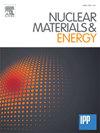Electron beam welding behavior in Eurofer subjected to the PbLi eutectic
IF 2.7
2区 物理与天体物理
Q1 NUCLEAR SCIENCE & TECHNOLOGY
引用次数: 0
Abstract
The weldability of Eurofer steel and the behavior of weld beads under relevant fusion conditions are critical factors to assess for future designs, specifically in the context of the Water-Cooled Lithium Lead (WCLL) blanket concept. Here, the area corresponding to the breeder blanket will be in direct contact with the PbLi eutectic alloy, which will flow continuously at temperatures between 400 °C and 550 °C. In this study, electron beam welding was performed on 1.4 mm thick Eurofer plates. These welded samples were subsequently exposed to flowing PbLi in the CiCLo loop at CIEMAT, maintained at 450 °C for 1000 h.
Prior to corrosion testing, the microstructure of the samples was characterized to evaluate the fusion zone width, bonding coefficient, and the presence of any defects or brittle joints. Acicular delta ferrite was observed, attributed to the high temperatures during welding and rapid cooling afterward. The potential for improved corrosion resistance through normalization treatment post-welding was also assessed. Following PbLi exposure, the specimens underwent the same microstructural characterization.
The results showed a significant microstructural change in the HAZ, which caused an increase in hardness in the HAZ; this result occurred in both the as-welded and heat-treated materials. It should be noted that non-negligible amounts of lithium were found in the HAZ, which is evidence of the diffusion of lithium from the molten eutectic into the interior of the material.
受PbLi共晶影响的欧共体电子束焊接行为
在相关的熔合条件下,Eurofer钢的可焊性和焊珠的行为是未来设计评估的关键因素,特别是在水冷锂铅(WCLL)包层概念的背景下。在这里,增殖毯对应的区域将与PbLi共晶合金直接接触,该共晶合金将在400℃至550℃之间连续流动。在本研究中,电子束焊接在1.4 mm厚的Eurofer板上。这些焊接样品随后在CIEMAT的CiCLo回路中暴露于流动的PbLi中,并在450°C下保持1000小时。在腐蚀测试之前,对样品的微观结构进行表征,以评估熔合区宽度、结合系数以及是否存在缺陷或脆性接头。观察到针状δ铁素体,这是由于焊接时的高温和焊接后的快速冷却。通过焊后正火处理提高耐蚀性的潜力也进行了评估。PbLi暴露后,标本进行了相同的微观结构表征。结果表明:热影响区发生了明显的显微组织变化,导致热影响区硬度升高;这一结果发生在焊接和热处理材料中。值得注意的是,在热影响区内发现了不可忽略的锂,这是锂从熔融共晶扩散到材料内部的证据。
本文章由计算机程序翻译,如有差异,请以英文原文为准。
求助全文
约1分钟内获得全文
求助全文
来源期刊

Nuclear Materials and Energy
Materials Science-Materials Science (miscellaneous)
CiteScore
3.70
自引率
15.40%
发文量
175
审稿时长
20 weeks
期刊介绍:
The open-access journal Nuclear Materials and Energy is devoted to the growing field of research for material application in the production of nuclear energy. Nuclear Materials and Energy publishes original research articles of up to 6 pages in length.
 求助内容:
求助内容: 应助结果提醒方式:
应助结果提醒方式:


